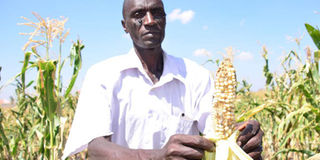Briefs from the world of farming and agribusiness

Christopher Muasya, a maize farmer, displays a maize cob ravaged by the fall armyworm in his farm in Kangundo. researchers now warn that a new variety of armyworm from the Americas has found its way into Africa. PHOTO | BRIAN OKINDA | NMG
What you need to know:
- According to the scientists, farmers first observed an outbreak in cassava fields in Nigeria in late 2016 and similar observations made in fields in nearby regions in early 2017.
- An examination of the moths identified and confirmed the pest as SAW, which belongs to the wide genus Spodoptera that incorporates 31 different species worldwide, including the ravaging FAW.
- Depending on the host plant and temperature, the southern armyworm can complete its life cycle within 30-40 days and is able to produce 1,500-3,000 eggs over its lifetime.
- Elijah Wachira, the MD CIC General Insurance Ltd noted insurers are involved in the food security cause by offering agriculture insurance.
Alarm as new armyworm cited in West, Central Africa
Researchers from the International Institute of Tropical Agriculture (IITA) have warned that a new variety of armyworm from the Americas has found its way into Africa.
The new pest, Southern Armyworm (SAW) or Spodoptera eridania (Stoll), has been discovered in West and Central Africa, heightening the food security danger posed by the initial fall armyworm (FAW) wave.
According to the scientists, farmers first observed an outbreak in cassava fields in Nigeria in late 2016 and similar observations made in fields in nearby regions in early 2017.
Samples of the larvae sent for diagnosis did not match the characteristics of FAW. The new species appeared to have origins closely resembling the African cotton leafworm.
It was thus determined the new species, widespread in tropical Africa and known to feed on various kinds of food, largely attacks sweet varieties of cassava less toxic to potential insect pests.
An examination of the moths identified and confirmed the pest as SAW, which belongs to the wide genus Spodoptera that incorporates 31 different species worldwide, including the ravaging FAW.
The discovery adds to the eight armyworm species already known in Africa, and being variable in their appearances. The SAW can hardly be identified based on physical characters alone.
They measure 33-38mm in length, are commonly cream or gray, have a faint kidney-shaped spot, and look identical in both sexes, with the only constant feature being a dark brown streak at the inner margin of their forewings.
With records of more than 200 host plants belonging to 58 plant families including many important crops, the species is probably the most polyphagous.
Depending on the host plant and temperature, the southern armyworm can complete its life cycle within 30-40 days and is able to produce 1,500-3,000 eggs over its lifetime.
An important circumstance however is that SAW and FAW share many important natural enemy species and IITA’s Deputy Director General for Research for Development, Dr May-Guri Saethre, says that while this trait may become a significant stabilising factor for common natural enemy populations, more research is urgently needed to assess its effective pest status.
****
Firms commit to agro insure
Insurance companies have been asked to invest and focus more on agriculture covers to ensure farmers avoid losses and sustain the country’s food security. Dr Paul Omanga, a food security consultant, said the move will cushion farmers from adversities thus attracting more to the farming profession.
“It is a little disheartening that many insurance companies have been focusing more on other indemnification covers, and not putting the requisite focus in agriculture,” said Dr Omanga during the Association of Insurance Brokers of Kenya (AIBK) conversation on food security, crop and livestock insurance forum yesterday.
Elijah Wachira, the MD CIC General Insurance Ltd noted insurers are involved in the food security cause by offering agriculture insurance.
“We have a wide range of insurance covers for farmers, depending on their activities; such as crop or livestock farming,” he said.





